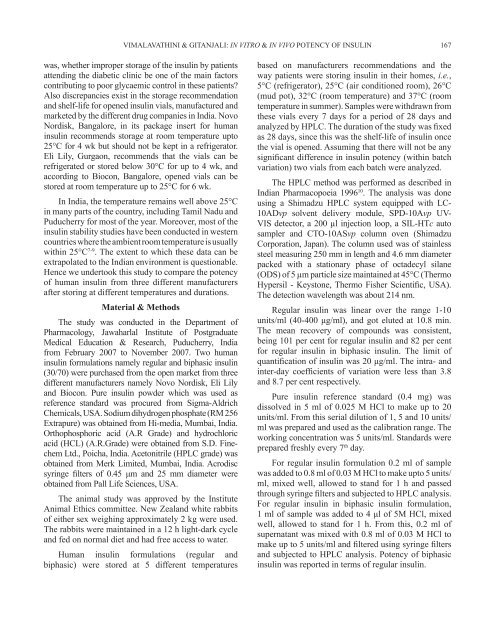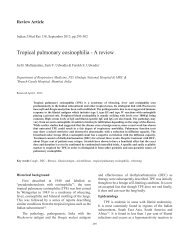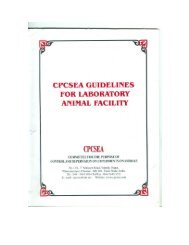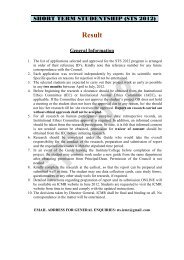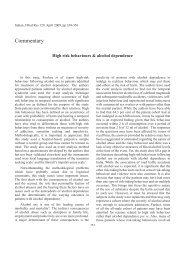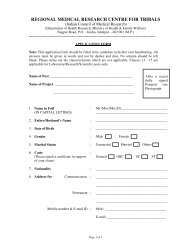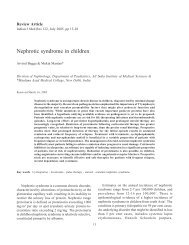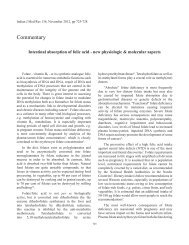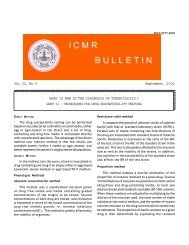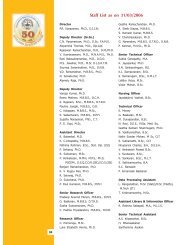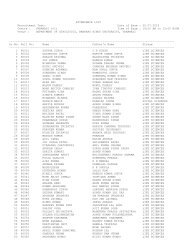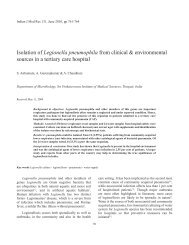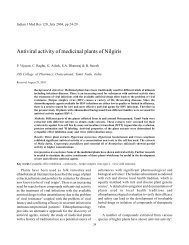Effect of temperature on the potency & pharmacological action of ...
Effect of temperature on the potency & pharmacological action of ...
Effect of temperature on the potency & pharmacological action of ...
Create successful ePaper yourself
Turn your PDF publications into a flip-book with our unique Google optimized e-Paper software.
VIMALAVATHINI & GITANJALI: IN VITRO & IN VIVO POTENCY OF INSULIN 167<br />
was, whe<strong>the</strong>r improper storage <str<strong>on</strong>g>of</str<strong>on</strong>g> <strong>the</strong> insulin by patients<br />
attending <strong>the</strong> diabetic clinic be <strong>on</strong>e <str<strong>on</strong>g>of</str<strong>on</strong>g> <strong>the</strong> main factors<br />
c<strong>on</strong>tributing to poor glycaemic c<strong>on</strong>trol in <strong>the</strong>se patients?<br />
Also discrepancies exist in <strong>the</strong> storage recommendati<strong>on</strong><br />
and shelf-life for opened insulin vials, manufactured and<br />
marketed by <strong>the</strong> different drug companies in India. Novo<br />
Nordisk, Bangalore, in its package insert for human<br />
insulin recommends storage at room <str<strong>on</strong>g>temperature</str<strong>on</strong>g> upto<br />
25°C for 4 wk but should not be kept in a refrigerator.<br />
Eli Lily, Gurga<strong>on</strong>, recommends that <strong>the</strong> vials can be<br />
refrigerated or stored below 30°C for up to 4 wk, and<br />
according to Bioc<strong>on</strong>, Bangalore, opened vials can be<br />
stored at room <str<strong>on</strong>g>temperature</str<strong>on</strong>g> up to 25°C for 6 wk.<br />
In India, <strong>the</strong> <str<strong>on</strong>g>temperature</str<strong>on</strong>g> remains well above 25°C<br />
in many parts <str<strong>on</strong>g>of</str<strong>on</strong>g> <strong>the</strong> country, including Tamil Nadu and<br />
Puducherry for most <str<strong>on</strong>g>of</str<strong>on</strong>g> <strong>the</strong> year. Moreover, most <str<strong>on</strong>g>of</str<strong>on</strong>g> <strong>the</strong><br />
insulin stability studies have been c<strong>on</strong>ducted in western<br />
countrieswhere<strong>the</strong>ambientroom<str<strong>on</strong>g>temperature</str<strong>on</strong>g>isusually<br />
within 25°C 7-9 . The extent to which <strong>the</strong>se data can be<br />
extrapolated to <strong>the</strong> Indian envir<strong>on</strong>ment is questi<strong>on</strong>able.<br />
Hence we undertook this study to compare <strong>the</strong> <strong>potency</strong><br />
<str<strong>on</strong>g>of</str<strong>on</strong>g> human insulin from three different manufacturers<br />
after storing at different <str<strong>on</strong>g>temperature</str<strong>on</strong>g>s and durati<strong>on</strong>s.<br />
Material & Methods<br />
The study was c<strong>on</strong>ducted in <strong>the</strong> Department <str<strong>on</strong>g>of</str<strong>on</strong>g><br />
Pharmacology, Jawaharlal Institute <str<strong>on</strong>g>of</str<strong>on</strong>g> Postgraduate<br />
Medical Educati<strong>on</strong> & Research, Puducherry, India<br />
from February 2007 to November 2007. Two human<br />
insulin formulati<strong>on</strong>s namely regular and biphasic insulin<br />
(30/70) were purchased from <strong>the</strong> open market from three<br />
different manufacturers namely Novo Nordisk, Eli Lily<br />
and Bioc<strong>on</strong>. Pure insulin powder which was used as<br />
reference standard was procured from Sigma-Aldrich<br />
Chemicals,USA.Sodiumdihydrogenphosphate(RM256<br />
Extrapure) was obtained from Hi-media, Mumbai, India.<br />
Orthophosphoric acid (A.R Grade) and hydrochloric<br />
acid (HCL) (A.R.Grade) were obtained from S.D. Finechem<br />
Ltd., Poicha, India. Acet<strong>on</strong>itrile (HPLC grade) was<br />
obtained from Merk Limited, Mumbai, India. Acrodisc<br />
syringe filters <str<strong>on</strong>g>of</str<strong>on</strong>g> 0.45 μm and 25 mm diameter were<br />
obtained from Pall Life Sciences, USA.<br />
The animal study was approved by <strong>the</strong> Institute<br />
Animal Ethics committee. New Zealand white rabbits<br />
<str<strong>on</strong>g>of</str<strong>on</strong>g> ei<strong>the</strong>r sex weighing approximately 2 kg were used.<br />
The rabbits were maintained in a 12 h light-dark cycle<br />
and fed <strong>on</strong> normal diet and had free access to water.<br />
Human insulin formulati<strong>on</strong>s (regular and<br />
biphasic) were stored at 5 different <str<strong>on</strong>g>temperature</str<strong>on</strong>g>s<br />
based <strong>on</strong> manufacturers recommendati<strong>on</strong>s and <strong>the</strong><br />
way patients were storing insulin in <strong>the</strong>ir homes, i.e.,<br />
5°C (refrigerator), 25°C (air c<strong>on</strong>diti<strong>on</strong>ed room), 26°C<br />
(mud pot), 32°C (room <str<strong>on</strong>g>temperature</str<strong>on</strong>g>) and 37°C (room<br />
<str<strong>on</strong>g>temperature</str<strong>on</strong>g> in summer). Samples were withdrawn from<br />
<strong>the</strong>se vials every 7 days for a period <str<strong>on</strong>g>of</str<strong>on</strong>g> 28 days and<br />
analyzed by HPLC. The durati<strong>on</strong> <str<strong>on</strong>g>of</str<strong>on</strong>g> <strong>the</strong> study was fixed<br />
as 28 days, since this was <strong>the</strong> shelf-life <str<strong>on</strong>g>of</str<strong>on</strong>g> insulin <strong>on</strong>ce<br />
<strong>the</strong> vial is opened. Assuming that <strong>the</strong>re will not be any<br />
significant difference in insulin <strong>potency</strong> (within batch<br />
variati<strong>on</strong>) two vials from each batch were analyzed.<br />
The HPLC method was performed as described in<br />
Indian Pharmacopoeia 199610 . The analysis was d<strong>on</strong>e<br />
using a Shimadzu HPLC system equipped with LC-<br />
10ADvp solvent delivery module, SPD-10Avp UV-<br />
VIS detector, a 200 µl injecti<strong>on</strong> loop, a SIL-HTc auto<br />
sampler and CTO-10ASvp column oven (Shimadzu<br />
Corporati<strong>on</strong>, Japan). The column used was <str<strong>on</strong>g>of</str<strong>on</strong>g> stainless<br />
steel measuring 250 mm in length and 4.6 mm diameter<br />
packed with a stati<strong>on</strong>ary phase <str<strong>on</strong>g>of</str<strong>on</strong>g> octadecyl silane<br />
(ODS) <str<strong>on</strong>g>of</str<strong>on</strong>g> 5 µm particle size maintained at 45°C (Thermo<br />
Hypersil - Keyst<strong>on</strong>e, Thermo Fisher Scientific, USA).<br />
The detecti<strong>on</strong> wavelength was about 214 nm.<br />
Regular insulin was linear over <strong>the</strong> range 1-10<br />
units/ml (40-400 μg/ml), and got eluted at 10.8 min.<br />
The mean recovery <str<strong>on</strong>g>of</str<strong>on</strong>g> compounds was c<strong>on</strong>sistent,<br />
being 101 per cent for regular insulin and 82 per cent<br />
for regular insulin in biphasic insulin. The limit <str<strong>on</strong>g>of</str<strong>on</strong>g><br />
quantificati<strong>on</strong> <str<strong>on</strong>g>of</str<strong>on</strong>g> insulin was 20 μg/ml. The intra- and<br />
inter-day coefficients <str<strong>on</strong>g>of</str<strong>on</strong>g> variati<strong>on</strong> were less than 3.8<br />
and 8.7 per cent respectively.<br />
Pure insulin reference standard (0.4 mg) was<br />
dissolved in 5 ml <str<strong>on</strong>g>of</str<strong>on</strong>g> 0.025 M HCl to make up to 20<br />
units/ml. From this serial diluti<strong>on</strong> <str<strong>on</strong>g>of</str<strong>on</strong>g> 1, 5 and 10 units/<br />
ml was prepared and used as <strong>the</strong> calibrati<strong>on</strong> range. The<br />
working c<strong>on</strong>centrati<strong>on</strong> was 5 units/ml. Standards were<br />
prepared freshly every 7th day.<br />
For regular insulin formulati<strong>on</strong> 0.2 ml <str<strong>on</strong>g>of</str<strong>on</strong>g> sample<br />
was added to 0.8 ml <str<strong>on</strong>g>of</str<strong>on</strong>g> 0.03 M HCl to make upto 5 units/<br />
ml, mixed well, allowed to stand for 1 h and passed<br />
through syringe filters and subjected to HPLC analysis.<br />
For regular insulin in biphasic insulin formulati<strong>on</strong>,<br />
1 ml <str<strong>on</strong>g>of</str<strong>on</strong>g> sample was added to 4 μl <str<strong>on</strong>g>of</str<strong>on</strong>g> 5M HCl, mixed<br />
well, allowed to stand for 1 h. From this, 0.2 ml <str<strong>on</strong>g>of</str<strong>on</strong>g><br />
supernatant was mixed with 0.8 ml <str<strong>on</strong>g>of</str<strong>on</strong>g> 0.03 M HCl to<br />
make up to 5 units/ml and filtered using syringe filters<br />
and subjected to HPLC analysis. Potency <str<strong>on</strong>g>of</str<strong>on</strong>g> biphasic<br />
insulin was reported in terms <str<strong>on</strong>g>of</str<strong>on</strong>g> regular insulin.


